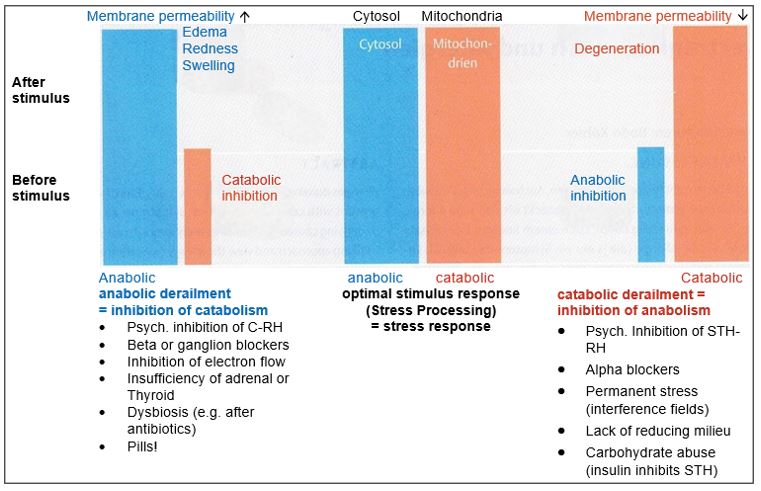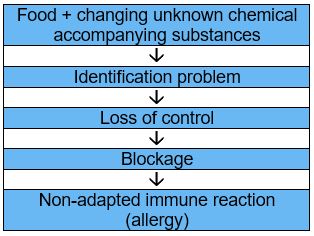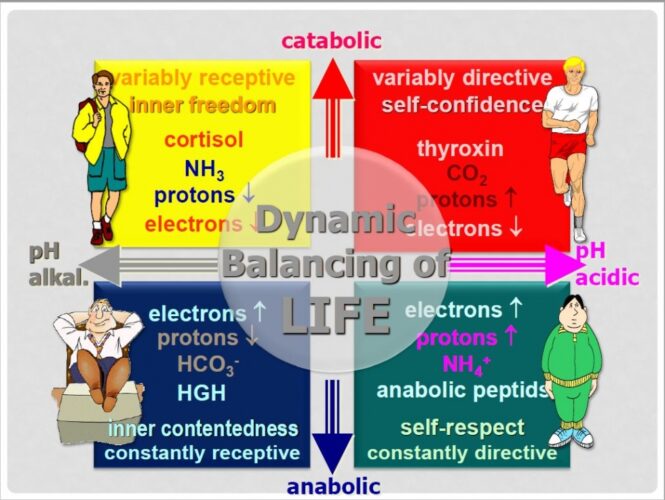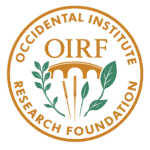Bioenergetic Procedures for
Food Intolerances and Allergies
SUMMARY
Allergies dominate doctors’ practices today. Even though many patients come with completely different symptoms, an allergy is often the underlying cause. It would be completely wrong to act according to a linear approach and view the allergy (which is merely a symptom) as the cause of these diseases. The correct thing to do would be to recognize the same anabolic reaction pattern behind it that also underlies other diseases, with all the diverse, highly individual causes. The goal on a somatic level should therefore always be to resolve the blockage of the catabolic metabolism. However, since it is usually an active protective mechanism of the organism, the true reasons must be identified. These lie in the loss of control. This can already show itself on the mental level, which is why the necessity of a holistic view of mind, soul and body once again becomes apparent here.
Keywords: Bioenergetic procedures, food intolerances, allergy, loss of control, metabolic regulation
Over the decades, a wide variety of diagnostic and therapeutic procedures for intolerances and allergies have been established, from kinesiology to bioresonance, everything is represented. But in the meantime, orthodox medicine has also refined its test procedures. It is becoming more and more difficult to keep up with everything. What makes sense, what is less, and what is perhaps just charlatanry? Despite all the research, the progression of allergies seems unstoppable. Could it be that the previous scientific approach is not right? Could it even be true that our science has no approach at all, because it cannot describe the vitality of being or has misunderstood it? I think it’s worth looking for other solutions. There are various useful approaches.
Metabolic Regulation
The starting point of the considerations should always be the regulation of cell metabolism as a reference system. This is because the main characteristic of every disease is that a normal stimulus-reaction response is no longer possible. The physiological stress adaptation of the cell metabolism is absent. In the case of allergy, excessive reactions occur. Therefore, attention should be directed to the control instances in the organism.
More than 40 years ago, Prof. Dr. Dr. Jürgen Schole published the scientific foundations of the regulation of cell metabolism within the framework of the three-component theory(7). The consequences that derive from this for medicine are comprehensive, because it allows direct access to all diseases, namely with regard to their development and treatment. Due to the extensive subject matter, only a few special features are put in the foreground here.
Anabolic synthesis metabolism and catabolic energy metabolism are interlinked and mutually dependent. Their activity is the same at rest. It is ensured by the so-called basic regulation, which is characterized by oxidation and reduction processes, i.e. by the constant exchange of electrons, a give and take. This alone ensures the “everyday metabolism” of the cells.
If there is sensory overload – this can be stress, but also exposure to toxins, microbes, viruses, etc. – then higher-level hormonal regulators come into force in order to bring about an appropriate adaptation to the stress as quickly as possible. In this case, both metabolic parts are not “ramped up” at the same time, but rather one after the other. The time delay, the “lagging behind”, is the extent of the disease. In a rested state – with corresponding reserves of cortisol and anabolic peptides – the balance at a higher energy level is already achieved after 1 hour. Otherwise it takes 4-5 days and can proceed with the symptoms of an acute illness (which must be understood as a healing reaction!) after the reaction phases according to Hans Selye (alarm reaction).
According to Schole, a metabolic regulation of the cells can only take place if 3 components are used at the same time: thyroid hormones and cortisol (have a catabolic effect) as well as STH (growth hormone) or rather the anabolic cell peptides. However, it is now known that STH, which could convert a predominantly catabolic metabolism (cardiovascular diseases, cancer, etc.) into normality, cannot be released if the insulin level rises due to too many carbohydrates or if there is permanent psychological stress (inhibits STH-releasing hormone).
In the other case of a predominantly anabolic metabolic state, adrenal fatigue may result in a deficiency of cortisol and/or dysthyroidism with insufficient release of thyroid hormones. In this case, regulating cell metabolism is also impossible. This should be examined and compensated for primarily by substitution.
 Figure 2: Regulation of cell metabolism and insufficient stress adaptation, left on the catabolic, right on the anabolic [arm of the cell metabolism] However, as can be seen from Figure 2, there are a whole range of other factors that can contribute to an inhibition of the balancing, anabolic versus catabolic [arm of the cell metabolism].
Figure 2: Regulation of cell metabolism and insufficient stress adaptation, left on the catabolic, right on the anabolic [arm of the cell metabolism] However, as can be seen from Figure 2, there are a whole range of other factors that can contribute to an inhibition of the balancing, anabolic versus catabolic [arm of the cell metabolism].
From this point of view, the reason for the failure to heal (not the disease itself!) can always be sought in the fact that the balancing forces cannot become effective for different(!) reasons.
In our reflections on the allergy problem, we therefore orient ourselves on the left side of Figure 2. The middle line indicates the initial state. Under the stress of an allergen, a stress adaptation takes place, but this is only anabolically effective. The catabolic [arm] is inhibited.
Health is right in the middle between anabolic and catabolic. The allergic reaction indicates an anabolic derailment, namely by blocking the catabolic [arm}. Some of the reasons for this are, for example, the intake of beta-blockers or dysbiosis of the intestine. However, in order to better understand the loss of control that has occurred, more far-reaching considerations are necessary.
 Fig. 3 Anabolic and catabolic diseases due to coupling.
Fig. 3 Anabolic and catabolic diseases due to coupling.
The 7 different information levels of the organism are connected via “interfaces” and cooperate with each other. In quantum theory, this is called “coupling” (Figure 3). A loose coupling that does not lead to “enslavement” would be the best. This preserves the constantly necessary adaptability (change ability) of the organism, and rigidity due to exaggerated order (which means inflexibility) would be avoided.
What are the coupling processes in the organism? It is not actually so; that everything is randomly connected to everything else, and that every cell communicates randomly with everyone else. On the contrary, a strict hierarchy is in existence by which the various systems and control levels are coupled “from top to bottom” and receive feedback “bottom to top”, creating cybernetic control loops(3). This separation into functional units can also be observed in the segmental structure of the organism (Mendeleev structures) and even in the energetic separation of both sides of the body (Quantum system “human”).
Working communities are in existence between the various organ systems without any dependencies forming. The information required for this is sent via different channels at the same time, encoded differently so that other systems are not disturbed by this “radio traffic”. In order to achieve this goal even in a confined space, the communication systems must be gradually expanded as the organism grows, from conception onwards. The information level must increase with growth. This also applies to regeneration processes, in which communication can be significantly disrupted at first. The vegetative system plays a decisive role in this.
In the anabolic diseases, to which allergies belong, there are therefore 2 problems at the same time:
- Inhibition of catabolic metabolic activity
- Rigid coupling of the information levels (with enslavement)
As a result, other systems react compulsively with what can lead to threatening derailments and even anaphylactic shock. This means: When massive allergic symptoms occur, it happens primarily because a system of rules had to do something different from what it was supposed to do – a kind of heteronomy, so to speak.
Loss of Control
But what is the reason that it does not lead to other anabolic diseases (e.g. rheumatism), but rather just to allergic symptoms?
Before the organism processes stimuli (input) as an open system, there is control. Our body is dependent on comparing everything and everybody with its stored patterns – which are necessary for the distinction between “friend” and “enemy”. This is a basic requirement, but it very quickly leads to problems if it is not “tomato” that is reported, but rather “tomato with something” (e.g. spray). Since the organism is capable of learning, it wouldn’t be so bad if the same thing were repeated more often. But what if today it says “food with preservatives”, tomorrow the same food but with dyes, the day after tomorrow with flavor enhancers, etc.? This may go well for a while, then complete confusion occurs, which is equated with loss of control. The organism responds with rigidity, with a blockage to protect itself (Figure 4).
 Figure 4 Development of an allergy.
Figure 4 Development of an allergy.
The non-adapted allergic reaction is therefore caused by the fact that the information processing cannot take place in the usual way according to the determined mechanisms, but under duress according to a wrong pattern that has been superimposed by other information levels (through rigid coupling).
 Figure 5 The interaction of the 4 elementary principles of existence. (A detailed explanation of the many individual aspects can be read in my book(6).)
Figure 5 The interaction of the 4 elementary principles of existence. (A detailed explanation of the many individual aspects can be read in my book(6).)
Translator note: the above English language version of this image was “borrowed” without permission from one of Dr. Köhler’s books – simply no way I could have duplicated the fancy graphics. But it is copyrighted to him!]
Four Elements
Further considerations of the problem result from the doctrine of the Four Elements. Here, the bipolarity (four-polarity) with the mutual interactions of the 4 elements is in the foreground. According to this, the allergy and its symptoms can initially be assigned to the water element (blue in Figure 5). According to the old language, water is the “master” of the earth (green), but is directed by it into pathways (intra- and extracellular space, vascular system). This obviously no longer works with the allergic reaction. There are classic anabolic (water) symptoms with increased membrane permeability (oedema, urticaria, runny nose, etc.). From this it can be deduced that the cells do not act according to a wrong (foreign) pattern.
Fire (red, metabolism) is normally in communication with the earth (tissue, cells) via electromagnetic oscillations, with simultaneous influence of the psychic constellation (self-confidence). But apparently the fire element heats up too much (increased anabolic activity) instead of scaling back. This speaks for a communication disorder at this level (due to coupling). Here, primarily external influences (e.g. e-smog) or internal causes (e.g. interference fields) could have an impact, and influence the flow of information.
The “master” of fire is air (yellow). This in turn communicates directly with the water (blood, lymph, cell water, extracellular space), indeed via mechanical pressure waves such as sound. Noises and mechanical irritations have an effect here.
The most elementary conclusion from these complex relationships is therefore that the loss of control that has occurred is compulsively caused by the application of an incorrect reaction pattern to substances which would actually show no threat to the organism, i.e. the allergic reaction is by no means voluntary.
There are therefore several factors in question which can have a positive effect on the subsequent (compulsive) allergic reaction in the event of a loss of control:
- Internal heat due to increased energy turnover
- Heavy physical exertion
- Psychological shock
- Noise
- Interference with electromagnetic information transfer (blockages, interference fields, etc.)
- Insufficiency of cells to control water (membrane permeability á)
- Incorrect allocation of modified foods
These considerations result in important rules of conduct, but at the same time several therapeutic approaches that can also be used in combination. Which measures are used in individual cases depends on the patient. The goal should be for the patient to tolerate all his food again.
Diagnosis
Since food intolerances are usually not allergies in the classic sense, but so-called fluctuations, static test procedures (prick, etc.) are not very expedient. Those affected often report that they do not constantly react with intolerance, but only sometimes, especially under stress. This should be taken into account in diagnostics and artificial stress conditions should be created. In this case, pressure on both sides of the skull or a cold hand bath is usually sufficient.
Since, according to the findings of quantum mechanics, the organism represents a quantum system that reacts as a whole and can assume different states at the same time, the location of the test is almost irrelevant. The changed sensitivity when coming into contact with the incompatible food is vital. This is used in electroacupuncture and the reduction of skin resistance is measured. Kinesiology is used to check the weakening of a test muscle and with the metabolic measurement to check the counter-regulation. Depending on how strong the body responses are with the different methods, a quantitative statement can also be made.
Over the decades(!), some special features have emerged. The main allergen in most patients is wheat, followed by milk and eggs. The neutralization of these 3 foods alone can bring resounding improvements in general well-being or other disease symptoms.
Therapy
Allergy solutions have been promoted for decades, but this is more of an allopathic and not a regulatory procedure. An interesting and promising new approach consists of intervening directly in the misclassification of the modified foods. Apparently, the whole event takes its course from here. For this purpose, the chemistry should be separated from the original substance in the organism in order to be able to excrete the toxins afterwards.
How can something like this be achieved? This requires an “attention signal”, a domain of Biophysical Information Therapy (BIT; or bioresonance). This stimulus sets the immune system on the track to free the organism from the respective accompanying substance. Then food can be used correctly again. The goal is therefore to train a new behavior that meets the requirements of our (highly polluted) time.
Specifically, this is achieved with bioenergetic methods by forming a difference signal between the information of completely natural food (from organic farming) and the food usually consumed. This is done automatically by a special electronic circuit in analogue BIT devices. This delta information is natively transferred to the thymus, at the same time stored in water and taken as drops. The differential signal is called “stressful chemistry” and thus acts as a targeted stimulus to excrete these substances. This ensures that the organism learns to separate the “small”, non-belonging part from the food. In this way, the underlying recognition problem is solved, which without treatment might have taken 2 or 3 generations to be epigenetically integrated.
However, it can be assumed that various impurities are present. Therefore, the process sometimes has to be repeated with the differently contaminated foods. Otherwise, a single treatment of 1-2 minutes is sufficient. To simplify things, a personal test set can be created with the different substances, so that the required materials are immediately available. To do this, all available basic foodstuffs from organic farming are first necessary.
So if we imagine that this very easy therapy with BIT trains the immune system to recognize friend and foe again without any problems, then it can turn undisturbed to the necessary regeneration processes, which increases the health potential and reduces the susceptibility to disease. This sets a beneficial development in motion.
For the sake of completeness, other therapeutic approaches are also listed that have also proven successful. The application depends on the possibilities in practice:
- Color-Tone therapy (chakra, constitution strengthening)
- Stress reduction of the psyche (conflict resolution, integration of the “shadows”)
- Balancing the vegetative system with vagus stimulation
- Coordination of both hemispheres of the brain (synchronization insula-amygdala)
- Metabolic correction
- Matrix Regeneration Therapy
- Symbiosis control (possibly with colon hydrotherapy)
- DC Magnetic Field therapy (supply of free electrons, e.g. with MRT)
- Membrane sealing (any catabolically effective therapy)
- Strengthening of the control organ pancreas (color green, silicea)
- Support of the endocrine glands (adrenal glands, thyroid, pituitary gland)
Conflict of interest: The author states that there is no conflict of interest.

An Exclusive Translated Article for P2P Supporters
From the Monthly Publications of P2P
Published February 2025
From an article in Erfahrungsheilkunde, Volume 73, Sept/Oct 2024
Machine Translation by Lernout & Hauspie, & Promt
Translation & redaction by: Carolyn L. Winsor, P2P Consulting
© Copyright 2024, EHK 2024; 73: 269-274 | © 2024, Thieme, Dr. Köhler, Germany
Literature
- Bischof M. Biophotonen – das Licht in unseren Zellen. Rottenburg: Kopp; 2001
- Dennison Befreite Bahnen. Freiburg: Angewandte Kinesiologie; 1984
- Heine H. Lehrbuch der Biologischen Medizin. Stuttgart: Hippokrates; 2014
- Köhler B. Biophysikalische Informations-Therapie. Norder-stedt: BoD; 2019
- Köhler B. Die Grundlagen des Lebens. Norderstedt: BoD; 2022
- Köhler B. Das Lehrbuch für die VEREINTE lebenskonforme MEDIZIN. Norderstedt: BoD; 2021
- Schole J, Lutz W. Regulationskrankheiten. Versuch einer fachübergreifenden Analyse. Norderstedt: BoD; 2005



